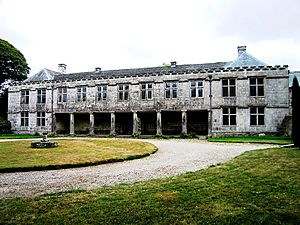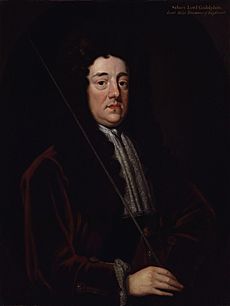Godolphin Estate facts for kids
Quick facts for kids Godolphin Estate |
|
|---|---|

Godolphin House
|
|
| Type | Country house |
| Location | Godolphin Cross, Breage, Cornwall, England |
| OS grid reference | SW 60129 31840 |
| Area | Cornwall |
| Built | 15th–17th centuries |
| Owner | National Trust |
|
Listed Building – Grade I
|
|
| Official name: Godolphin House | |
| Designated | 10 July 1957 |
| Reference no. | 1158437 |
| Official name: Godolphin | |
| Designated | 15 December 1999 |
| Reference no. | 1001443 |
|
Listed Building – Grade I
|
|
| Official name: Stabling and cobbled pavements adjoining Godolphin House | |
| Designated | 26 August 1987 |
| Reference no. | 1158586 |
|
Listed Building – Grade I
|
|
| Official name: Forecourt walls, stiles and mounting block at Godolphin House | |
| Designated | 26 August 1987 |
| Reference no. | 1142259 |
|
Listed Building – Grade I
|
|
| Official name: Blowing House and attached walls north-east of Blowing House Cottage on the Godolphin Estate | |
| Designated | 14 September 1984 |
| Reference no. | 1142264 |
| Lua error in Module:Location_map at line 420: attempt to index field 'wikibase' (a nil value). | |
The Godolphin Estate is a special place in Cornwall, England. It is owned by the National Trust, a charity that protects historic places. The estate is about 7 kilometers (4.3 miles) northwest of Helston. Its main house, Godolphin House, is a very important historic building. It is listed as Grade I, meaning it has special architectural or historic interest.
Contents
History of Godolphin Estate
The Godolphin Estate was once home to important families. These included the Dukes of Leeds and the Earls of Godolphin. The estate has a large house built between the 1500s and 1600s. It also has old formal gardens and stables from around 1600. The house you see today is part of a much larger mansion that used to be there.
Who Owned Godolphin House?
From 1786, the Dukes of Leeds owned the estate. However, they never actually lived there. In 1920, the 10th Duke of Leeds sold it to a tenant named Peter Quintrell Treloar. After Treloar passed away in 1922, his wife sold it to James Penna in 1923. Penna was an agricultural engineer.
James Penna died in 1926. His son, James Henry, lived at the house until 1935. Then, a local man named C.B. Stevens bought it. In 1937, Stevens sold the house and estate to an artist, Walter Elmer Schofield. Schofield's son, Sydney, was an architect. He helped restore the mansion. His parents then gave it to him as a wedding gift.
Godolphin Today
In 2000, Sydney Schofield's widow, Mary Schofield, sold most of the estate to the National Trust. In 2007, the National Trust also bought the house, gardens, and farmyard. They worked hard to fix up the old parts of the house. This was to stop them from falling apart.
Today, Godolphin House is open to visitors on certain days. The estate covers about 550 acres (220 hectares). It includes Godolphin Hill, which offers amazing views of west Cornwall. Many old things have been found here. These include ancient Bronze Age enclosures and 19th-century mine buildings. The National Trust is making it easier for people to visit and explore the estate.
The village of Godolphin Cross is right next to the estate. It has a primary school for children.
Godolphin House and Gardens
Godolphin House is a beautiful old building. It often hosts different events throughout the year. You approach the house from the north. It has three wings built around a square courtyard. There is also a front wall of another building on the south side.
The main parts of the house were originally to the south. They had two wings sticking out. One room from the 1500s is still in the east part of the house. It has special wooden panels called linenfold panelling. Across from the main hall is the Jacobean part of the house. The north side looks like a castle. It has a covered walkway with seven arches on the ground floor. Some parts of the house look like they were built in the mid-1600s. This means the idea that the house was built after 1712 is probably wrong.
You can even rent the house for holidays for about three weeks each month. This is when it is not open to the public.
Important Historic Buildings
Godolphin House is a listed building with the highest rating, Grade I. This means it is very important. Three other buildings on the estate are also Grade I listed. These are the stables, the walls around the front courtyard, and a blowing house. A blowing house was used to melt tin.
Many other buildings on the estate are listed as Grade II. This means they are also important, but not as much as Grade I. These include:
- Two sets of gates and gateposts on the drive to the house.
- Some garden walls.
- Three buildings from the tin mining days: a counting house, a cottage next to the Blowing House, and a storage area for gunpowder.
- Farm buildings like a cider house, a piggery, a barn, a granary, and a cart shed.
The Godolphin Estate is part of the Cornwall and West Devon Mining Landscape. This is a special area recognized by UNESCO as a World Heritage Site.
Local Stories and Traditions
There is an old story about Godolphin Estate. It was first written down in the 1700s, but it might be much older. Every year on February 2nd, a tradition took place until 1921. The story says that two important families, Godolphin and St Aubyn, made a bet. They raced two snails. Godolphin lost the race because he pricked his snail, and it curled up.
Instead of taking Godolphin's estate, St Aubyn set up a yearly custom. A person called the reeve (a local official) from Lambourne would knock on the door of Godolphin Court. He would demand to be let in. Then, he would jump on a table and ask for "rents, duties, and customs." These were paid with a large amount of strong beer, a loaf of bread, some cheese, and a small amount of money (2 shillings and 8 pence).


